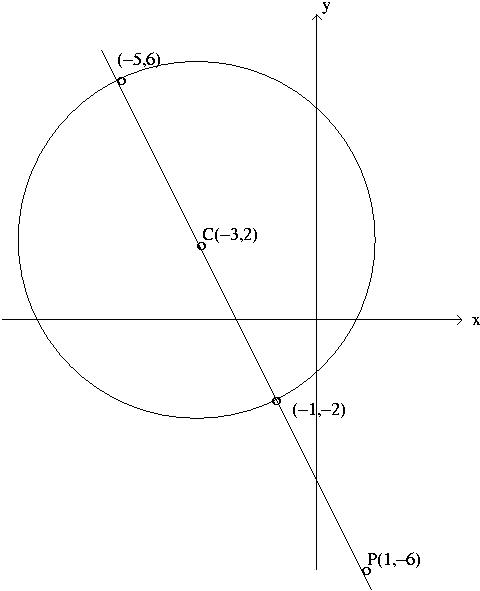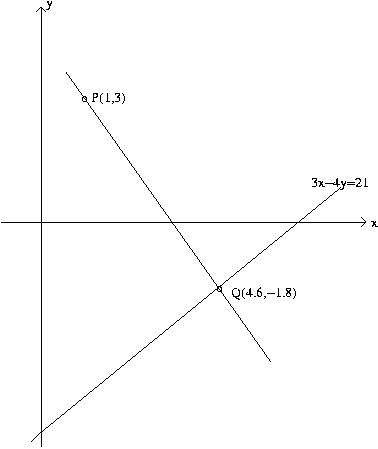Rectangular Coordinates
Sol A The circle has an equation of the form
![]() or
or ![]() where
where ![]() is the distance from
is the distance from ![]() to the origin;
so
to the origin;
so
![]() and the circle has the
equation
and the circle has the
equation ![]() .
.
Sol B The midpoint of the line segment AB is given by
![]() , so the circle has the equation
, so the circle has the equation
![]() .
.
Sol 1 The midpoint of the line segment AB is given by
![]() , so the distance from P to M is equal to
, so the distance from P to M is equal to
![]() .
.
Sol 2 The radius of the circle is the distance from C to the x-axis, so
![]() . Therefore the circle has equation
. Therefore the circle has equation
![]() .
.
Sol 3 The circle has an equation of the form
![]() , where
the radius
, where
the radius ![]() is the distance from C to P. Instead of using the distance
formula, though, we can substitute the coordinates of P into the equation to get
is the distance from C to P. Instead of using the distance
formula, though, we can substitute the coordinates of P into the equation to get
![]() or
or
![]() .
.
Sol 4 The radius of the circle is the distance from C to the line ![]() ,
so
,
so ![]() . Therefore the circle has equation
. Therefore the circle has equation
![]() .
.
Sol 5 The center C of the circle is the midpoint of the line segment
between P and Q, so
![]() . Therefore the circle has
an equation of the form
. Therefore the circle has
an equation of the form
![]() , where
, where ![]() is the distance from
C to P (or Q). Instead of finding
is the distance from
C to P (or Q). Instead of finding ![]() first, though, we can substitute the
coordinates of P into this equation to get
first, though, we can substitute the
coordinates of P into this equation to get
![]() or
or
![]() .
.
Sol 6 First we can find the center and radius of the circle
![]() by completing the square:
by completing the square:
![]() gives
gives
![]() , so the circle has center
, so the circle has center ![]() and radius
and radius ![]() .
The distance from P to C is given by
.
The distance from P to C is given by
![]() . Since
. Since ![]() , the point P is inside the circle.
, the point P is inside the circle.
Sol 7 The center of the circle is the point ![]() , and the slope of the
line through P and C is given by
, and the slope of the
line through P and C is given by
![]() . Therefore the line
through P and C has the equation
. Therefore the line
through P and C has the equation
![]() or
or ![]() , and the point on
the circle closest to P will be one of the points of intersection of this line
with the circle.
Substituting
, and the point on
the circle closest to P will be one of the points of intersection of this line
with the circle.
Substituting ![]() into the equation of the circle gives
into the equation of the circle gives
![]() , so
, so
![]() or
or ![]() . Then
. Then
![]() , so
, so ![]() and
and ![]() or
or ![]() . Since the x-coordinate of
P is 1, the point on the circle closest to P has
. Since the x-coordinate of
P is 1, the point on the circle closest to P has ![]() and
and ![]() ; so
it is the point
; so
it is the point ![]() .
.

Sol 8 First we will find an equation of the line through P which is
perpendicular to the given line. Solving ![]() for
for ![]() gives
gives
![]() , so the given line has slope
, so the given line has slope ![]() and therefore a line
perpendicular to this line will have slope
and therefore a line
perpendicular to this line will have slope
![]() .
.
Thus the line through P perpendicular to the given line has equation
![]() or
or ![]() . These two lines will intersect at a point
Q which is the point on the given line closest to P, and we can find the
coordinates of Q by substituting
. These two lines will intersect at a point
Q which is the point on the given line closest to P, and we can find the
coordinates of Q by substituting ![]() into the equation
into the equation ![]() and then solving:
and then solving:
![]() gives
gives
![]() or
or
![]() , so
, so
![]() and
and
![]() .
Therefore Q is the point
.
Therefore Q is the point ![]() ,
,
and the distance from P to the line is
the distance from P to Q, which is given by
![]() .
.

Return to the Problems for this
Topic.
Return to Precalculus Home Page.